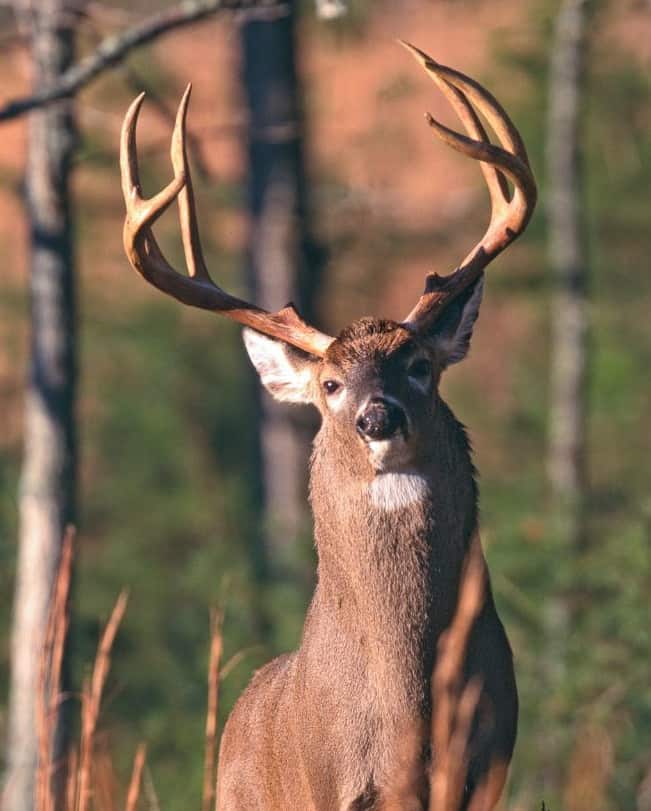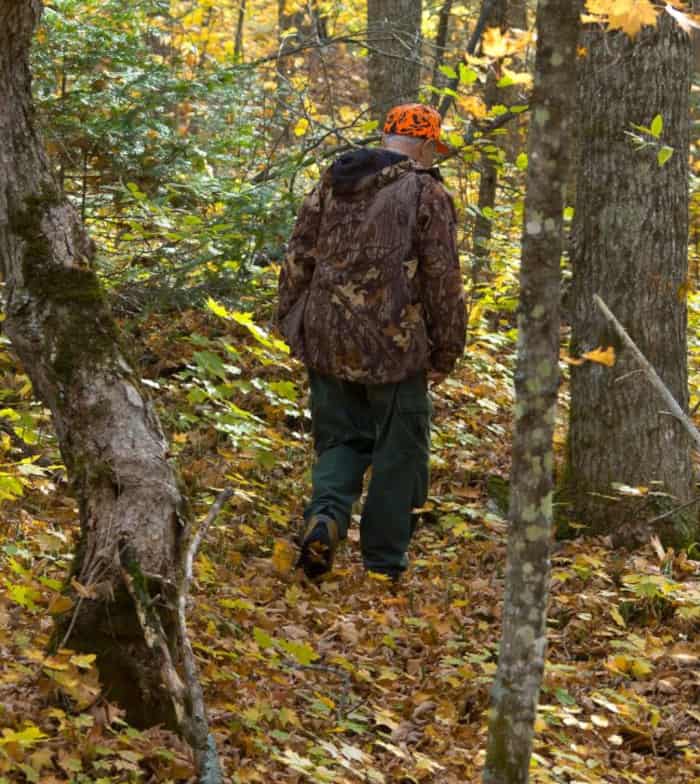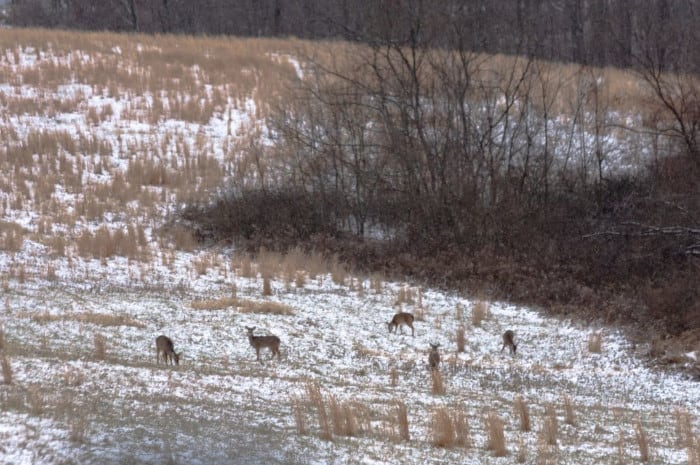Nearly every state in the continental U.S. offers some type of land access for outdoors people and hunters. For some hunters, publicly available land is their only hunting option. Given the popularity of open access hunting properties, hunting in these public areas can be challenging as there are far more hunters competing for game compared to private hunting land. At my day job, I’m often asked about hunting public land, so I thought it might be helpful to put together some public land deer hunting tips and tricks to increase your odds of success.
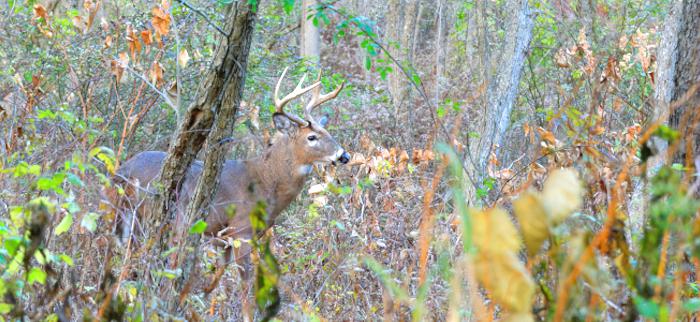
Having hunted bucks and does on public-land in several states over the years, I’m aware of the challenges a hunter faces on this land as I’ve faced those same challenges.
Things to Know Pre-Hunt
Before I get into discussing the tips and suggestions, let me take a second to mention two very important points to be aware of before venturing out to hunt publicly accessible land.
Know the Rules & Regulations of the Public Land Being Hunted
This is important, so pay attention to it, or it could cost you some money or your hunting privileges. Special rules or regulations usually govern publicly available land, and it’s vitally important to be thoroughly aware of those regulations. Here’s a sample of a few specific rules that I’ve come across while hunting on publicly accessible lands in different states:
- Caliber restrictions
- Tree stand height requirements
- Shotgun with buckshot only rules
- Specific hunting days for particular game species
- No shooting ground level with a centerfire rifle
- No handgun being carried while hunting public-land deer
- Buck only restrictions
- Minimum antler point or size rules
These types of rules can get you into trouble, especially if you are unaware of them. I’ve spoken to several game wardens and wildlife conservation officers who have mentioned that they see more violations on public spots han in any other location.
Hunter Safety is Paramount
When public-land hunting, you’d likely be sharing that land with far more hunters than you would hunting on private land. The increased number of hunters in the woods and the potentially close proximity of those other hunters can lead to potentially dangerous situations, so it’s vital to utilize and practice hunter safety.
For example, regardless of the legal requirements of a specific patch of public ground, I always suggest wearing some hunter-orange clothing. And I’ll go a step further and recommend that you wear as much as possible so other hunters can see you.
Almost every patch of publicly accessible land I’ve hunted across different states has hunter-orange requirements, so I’ve always made sure I wore enough orange to increase my chances of being seen.
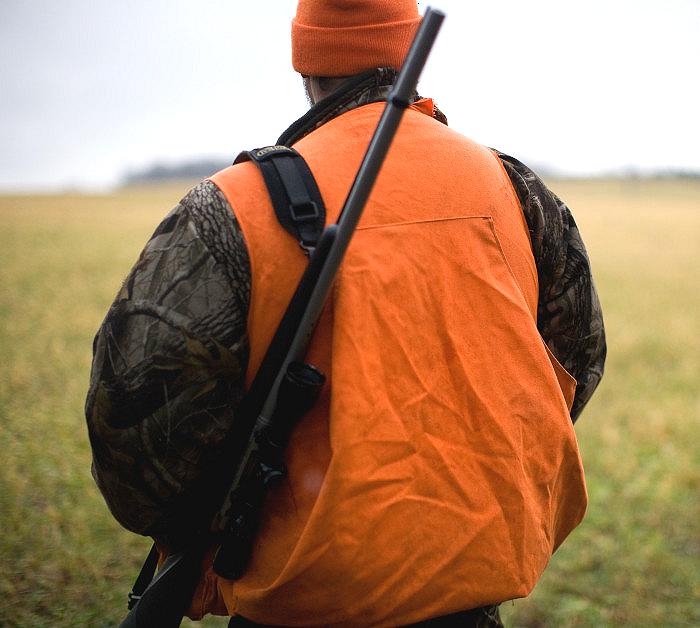
8 Tips & Tricks for Hunting Deer on Public Land
Here are 8 of my favorite tips and tricks that I’ve picked up over the years that have helped me bag some very nice mature bucks on public-managed land:
#1 – Do Pre-hunt Scouting
While this sounds like a basic suggestion that almost every hunter is already doing, you’d be surprised how many whitetail hunters walk in and pick a spot that “looks good” on the first day of the season with no prior scouting.
You’ll significantly increase your odds of seeing bucks and does by doing pre-season scouting. I look for deer-based activity signs like:
- Game trails
- Rubs
- Scrapes
- Food sources
However, here’s something else to be aware of with pre-season scouting with public land hunting: when the public-land crowds hit the woods on day one of the season, the does and bucks will change their patterns and habits to account for all the disturbances.
I try to keep that in mind when public-land hunting as it may be necessary to transition to another location or hunting approach if needed. The ability to pivot or change tactics is where you see the actual value of pre-season scouting. You can shift to another approach or location due to your scouting.
#2 – Take Advantage of Maps
When I first started hunting deer, there wasn’t an easy way to access a map of a particular area, especially one with topological features. Back then, the only way to get a feel for the property and potential hunting spots was an old-fashioned exploration on foot.
You can now utilize online resources to get a birds-eye view of any potential hunting property. Google Earth is a great resource that I routinely use to review hunting properties. The things I look for on an online aerial image are the following:
Parking Spots
This sounds kind of basic, but a large percentage of hunters on publicly accessible land won’t travel more than 50 yards to 100 yards from their vehicle to hunt, or want to hunt close to the road. By locating the common parking areas for a public hunting spot, you can quickly determine where NOT to hunt.
Waterways
An aerial image can also be used to locate waterways such as rivers, ponds, creeks, etc. These water properties can be incorporated into a hunting plan via scouting. Does and bucks need water, so a well-traveled crossing point on a creek or watering location can be an excellent location to hunt.
Old Road or Paths
Topological images can also be used to locate old roads, paths, or trails. Bucks and does could be using these paths for travel, and these old roads are also ideal for a hunter who wants to still hunt on the move.
I find that old logging roads or paths are well worth investigating while scouting and have stumbled on some excellent hunting spots along these types of paths.
Bedding Areas
Bucks and does prefer not to bed down in the open, so they need a bedding area that offers them some cover. Reviewing topography maps can be a great way to identify potential bedding areas. Once an active bedding area is identified, setting up along the typical travel path from a food source to bedding can be a very effective approach.
#3 – Hunt the Midday
This tip has been a massive success for me and allowed me to bag several bucks on public land (and a few does) where other hunters were striking out.
Most public land hunters do the following:
- Get in the stand or woods before dawn and hunt until around 10 AM to 11 AM. Then they will exit their stand and head back to their vehicles for lunch, something to drink, and a nap.
- At around 3 PM, those hunters will return to their stand and hunt until dark.
The animals learn those patterns and adjust their activity accordingly. I’ve lost count of the number of big deer I’ve seen on state managed hunting land between the hours of 11 AM to 3 PM. One of the largest public land bucks I’ve bagged so far came walking by my stand at 1 PM in the afternoon headed back to a bedding area.
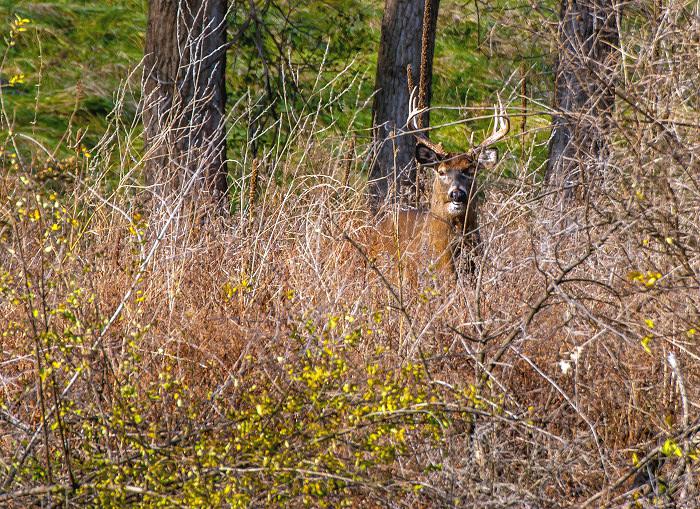
If you want to significantly increase your opportunities to fill your tag on public tracts, plan to stay in the stand all day. Pack a lunch and wait the mid-day period out. You may be pleasantly surprised at the results.
#4 – Talk with the Land Manager or Biologist Assigned to the Land
In some states, a state manager is assigned to a specific tract of public land, and some other states assign a biologist. The people assigned to those positions will likely be familiar with the deer population on that specific property or wildlife area. Chances are that the land manager knows where the animals are congregating, their preferred diet, where they are bedding, easy hunter access points, etc.
Most of those folks will gladly share that information if asked. The thing is: hardly anyone takes the time to identify these managers or contact them. Yet, they may be a valuable untapped resource that can give you an edge over other hunters.
#5 – Skip the First Week of the Season
I genuinely struggle to follow my own advice as I really want to be in the woods when the season opens. However, research has indicated that the opening day of deer season and the first full week of deer season are the most popular time for hunters on public land. That means that probably 90% of the hunters who utilize public land will be in the woods hunting deer during the first week of the season.
Typically, public deer land sees the following activity:
- A busy and crowded opening day of bow, muzzle, and gun season.
- This continues until the end of the first week of the season, then drops off significantly.
- By the end of the season’s second week, maybe 10% of the hunters from the opening day are back in the woods.
Rather than hunt on opening day, consider waiting until the first week of the season is over, then hunt the remainder of the season hard.
#6 – Hunt the Areas No One Else Will
Most public-land hunters prefer to hunt open spots or easy-to-reach spots that look promising. In public hunting land with significant hunting pressure, try hunting in the areas where no one else will, and away from the crowds because these areas likely hold deer.
These areas include locations like:
Dense Thicket Edges
When hunting pressure picks up, most bucks and does head for areas, they won’t be bothered. One popular location is dense thickets or underbrush. These areas are likely bedding areas, but most hunters won’t venture into a dense thicket to hunt.
I’ve had good hunting success right along the edge of the thick stuff. I typically try to slip in as quietly as possible, find the tallest tree on the edge of the thicket that offers the best viewpoint, and use a self-climber to get up high. You’d be surprised at the number of whitetails that I’ve seen this way, either moving through the thicket or to and from the thicket.
You could slip into the thicket itself and try to hunt, but it’s challenging to move through thick cover quietly, and you’ll probably bump more animals than you see.
The biggest drawback to this type of hunting is the availability of a good stand location, and limited shot access due to limited shooting lanes. In addition, you may have to patiently wait for a shot if the brush is really thick.
Flooded Timber
Most hunters will avoid flooded timber like the plague for two reasons:
- It generally requires waders to hunt
- The belief that whitetail deer don’t like to walk through water.
While you may need waders to hunt flooded sections, I find that hunting pressure will drive deer into these flooded areas, and the animals don’t seem to mind walking through various water levels.
I stumbled on this while duck hunting with a few friends. I kept noticing that we saw a substantial amount of deer while duck hunting flooded timber, as long as the water wasn’t too high.
One year, during an unsuccessful few days of hunting some public land in Virginia, I decided to slip on some waders and go hunt some of the flooded timber areas nearby. I saw more whitetails in the one afternoon in the timber versus the prior three days of hunting. I didn’t get a shot on a nice buck, but it started to prove my theory about flooded timber.
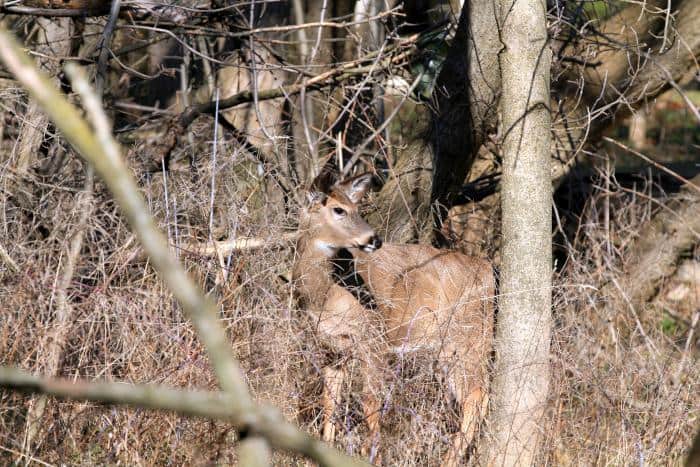
Swamps
Swampy or low-lying flooded areas can be another good area to hunt that will be missed or avoided by most hunters. A good friend turned me onto this tip when I went down to bow hunt with him in South Carolina.
He mentioned bringing waders as we might hit a swampy hunting area with several big bucks. And it was a good thing I did bring a pair of waders as we hunted a piece of public land that included a large swampy area. We ended up hunting in the swamp near a piece of dry high ground that deer were using as a bedding area. On the second day of that hunt, I harvested my second largest buck (to date) taken with a bow.
Like hunting flooded timber, most hunters don’t want to wear waders and venture into a muddy swamp to hunt deer. The deer have probably figured this out, which is why they stay in the swampy areas.
Traveling through a true swampy can be challenging due to the conditions, but it can be well worth the hassle.
#7 – Hunt the Second or Late Season Rut
Most states have a primary and secondary rut, which is the Whitetail deer’s mating season. Probably 98% of hunters on public land focus on the primary mating season, which is the first mating season that occurs during hunting season.
However, there’s also a secondary rut period that occurs later in the hunting season. It may be worth your time to hunt the secondary mating season on public access land because there will be little to no competition from other deer hunters. In addition, deer are very active in the secondary mating period, especially the big bucks.
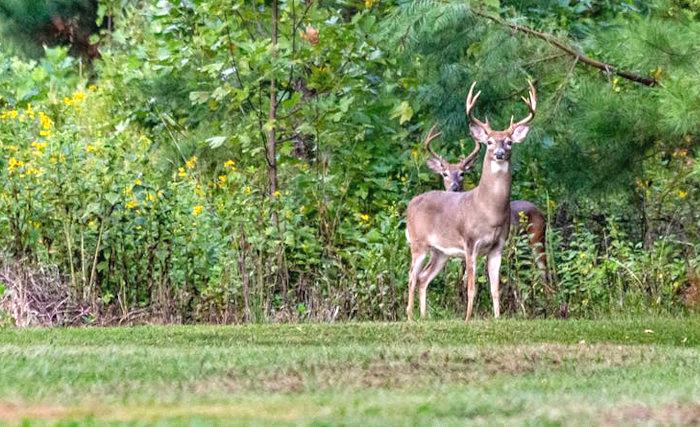
#8 – Trail Cameras are Your Friend (Where Legal)
If legal where you hunt, consider using game cameras to gain insight into the whitetails movement and habits. Game cameras offer an excellent opportunity to see images of deer in an area and develop intel to pattern their habits.
Again, where legal, I’d suggest setting up a few cameras during the pre-season scouting phase, as the information provided can be invaluable.
A few caveats about game cameras on public land:
- Not all public land regulations will allow the use of a trail or game camera, so be sure to research the regulations.
- Game cameras on public land are more likely to be stolen or removed, so I try to use older, less expensive camera models. I’m also a huge fan of cellular-based trail or game cameras that will send pics to your phone. Using a cellular camera lets me see images without returning to the camera to manually check the S.D. card.
Let’s be honest, hunting on public land is not easy, especially compared to private land hunting. However, you can be very successful on public land with a little planning and thinking outside the box.

Born and raised in Indiana, Brantley spent his youth chasing deer and turkey and, along the way, developed a passion for bowhunting. Although he still enjoys other types of hunting, his true passion is bowhunting, and he has or will author most all the bowhunting content on this site. Outside of work, Brantley is married and the father of two beautiful little girls. Brantley has worked in the hunting industry, with an emphasis on archery and bowhunting, for more than ten years.



